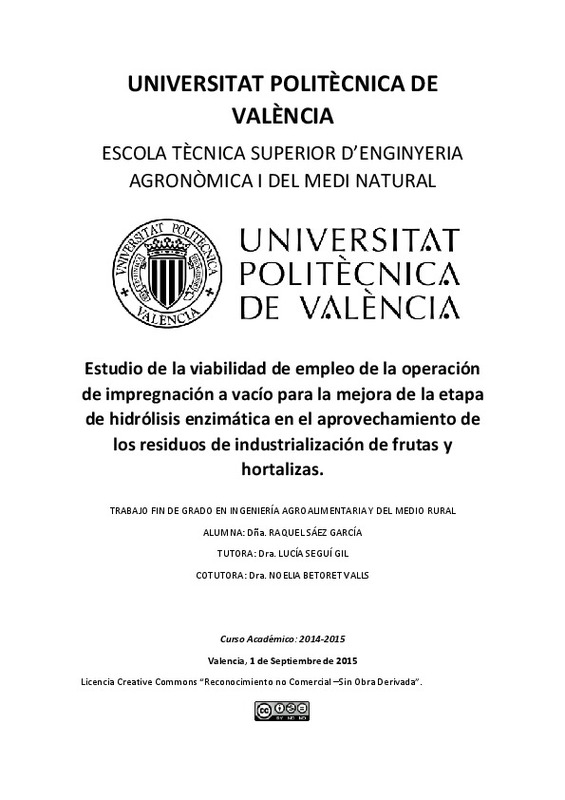|
Resumen:
|
[ES] El trabajo fin de grado que se propone tiene dos objetivos principales: en primer lugar, realizar un análisis de la producción de residuos de industrialziación de frutas y hortalizas a nivel nacional, y en segundo ...[+]
[ES] El trabajo fin de grado que se propone tiene dos objetivos principales: en primer lugar, realizar un análisis de la producción de residuos de industrialziación de frutas y hortalizas a nivel nacional, y en segundo lugar, estudiar la posibilidad de que la operación de impregnación a vacío se pueda utilizar para mejorar la hidrólisis enzimática de dichos residuos.
La hidrólisis enzimática para la obtención de azúcares fermentables es un paso previo necesario para la obtención de productos de valor añadido a partir de subproductos agrícolas, como ocurre en el proceso del proceso de obtención de bioetanol o de otros metabolitos de origen microbiano. No obstante, obtener buenos rendimientos requiere en general de pretratamientos ya que la accesibilidad de los enzimas a la matriz lignocelulósica que compone dichos residuos está bastante limitada debido a la complejidad de dicho material. Uno de los objetivos de los pretratamientos es aumentar la porosidad del material con el fin de aumentar el área de contacto enzima-sustrato. Puesto que la impregnación a vacío es una operación que permite sustituir el aire ocluido en los poros de una matriz sólida por una disolución que contenga el compuesto de interés, podría constituir en sí misma una manera de aumentar el contacto entre el enzima y los compuestos hidrolizables. En este sentido, el presente trabajo pretende evaluar la potencial aplicación de la impregnación a vacío en la mejora de la hidrólisis enzimática de residuos originados en la industria alimentaria. En primer lugar, el trabajo plantea una búsqueda bibliográfica exhaustiva con el fin de determinar qué subproductos podrían resultar de interés debido tanto al porcentaje de industrialización del producto como a la cantidad de subproducto generado en el proceso. Una vez decididos los subproductos sobre los que se va a trabajar, se caracterizarán fisicoquímicamente (xw, Brix, aw) y se obtendrán los parámetros característicos del mecanismo hidrodinámico (HDM) por ensayos de impregación a vacío con disoluciones isotónicas. Finalmente, se realizarán tratamientos de hidrólisis enzimáticaempleando celulasa y hemicelulasa de Aspergillus niger, para finalmente comparar los resultados con el residuo hidrolizado en las condiciones habituales (sin aplicar la operación de IV).
[-]
[EN] Due to the big amount of residues generated by the food industry, the interest in the
degradation and use of these waste materials increases. Nowadays, one of the most
developed alternatives is the use of agroindustrial ...[+]
[EN] Due to the big amount of residues generated by the food industry, the interest in the
degradation and use of these waste materials increases. Nowadays, one of the most
developed alternatives is the use of agroindustrial residues or byproducts in biofuels
production. Previous studies show that it is possible to obtain biofuels from fruit and vegetable
lignocellulosic materials. Particularly, the yield of the fermentation stage is significantly
influenced by degree of hydrolysis and the subsequent access of the fermenting bacteria to
the fermentable substrates. In the present study, the viability of using vacuum impregnation to
improve the stage of enzymatic hydrolysis is studied with the aim of improving the use of
these residues generated in the food industry.
Four different residues orange, banana, artichoke, bean), were selected taking into
account production values of the total residues, availability during the progress of the present
work and porosity characteristics. Apparent density, water activity, humidity, Brix degrees and
impregnation capacity on the sliced and minced residues with different solutions: hypotonic,
isotonic, with mannitol and isotonic with fructose, were determined for all residues. The
minced residues, impregnated or not, were submitted to a treatment of enzymatic hydrolysis
and degree of hydrolisis was evaluated by measuring Brix degrees and the sugars fructose,
glucose and sucrose, which were determined by ion exchange chromatography.
Both, impregnation capacity and results of enzymatic hydrolysis suggest that, in general,
the impregnation of the residues is more successful when these are minced and, in most cases,
vacuum impregnation results in an improvement of the hydrolysis stage. Only in the case of
the orange peel, the use of the isotonic solution prepared with mannitol provides better
results when vacuum impregnation is not used.
Therefore, the general conclusion of the present work is that the optimization of the
vacuum impregnation operation applied previously to the stage of enzymatic hydrolysis of
certain agro-industrial residues, could imply an increase in the hydrolysis performance, which
would result in an increase in the bioethanol production process.
[-]
|








